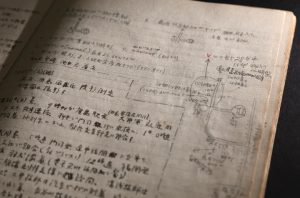Documenting Hiroshima of 1945: September 28, plants with abnormalities found near hypocenter
Sep. 28, 2024
by Kyosuke Mizukawa, Senior Staff Writer
On September 28, 1945, Hiromi Nakayama, from Japan’s Institute of Physical and Chemical Research (Riken), was investigating grasses growing in an area near the Hiroshima Gokoku Shrine, located near the hypocenter.
In the area around the Hiroshima Gate Park’s current location (in the city’s Naka Ward), Mr. Nakayama “found numerous deformed plants with spots.” On a page dated September 28 from his daily survey log, he noted the finding with a rough sketch of the local area. Regarding caster bean plants, he found that “a total of 11 of 28 were deformed with spots.” Such variation could have occurred naturally, but a malformation rate of nearly 40 percent was high.
At Riken, Mr. Nakayama worked in the laboratory of the atomic physicist Yoshio Nishida and had experience in investigating abnormal plant development after radiation exposure when the plants were seeds or in the seedling growth phase. In particular, his findings pointed to a high rate of plants with spots following exposure to radiation.
In his biological survey work as a member of a special task force for investigation of destruction from the atomic bombing formed by a Japanese Ministry of Education research council, Mr. Nakayama came to Hiroshima City on September 21, aiming to investigate the impact of A-bomb radiation on plants. A team of Nippon Eigasha, the company engaged in production of a documentary film, accompanied him.
Despite Mr. Nakayama’s focus on leaves with spots, few plants remained in the incinerated central area of Hiroshima. However, he was able to find a place relatively unaffected by the fires on one corner in the vicinity of the Gokoku Shrine, located around 200 meters from the hypocenter.
According to a report by Mr. Nakayama that was included in the Collection of Reports on the A-bomb Damage, published in 1953, he considered the spotted caster bean plants in that location to be “specimens with abnormalities assumed to have been caused by radiation.” The parts of the plants aboveground had died from the thermal rays generated at the time of the atomic bombing, but he assumed that the deformations he witnessed were the result of the growth of the underground parts of plants that had survived the exposure to radiation.
According to Mr. Nakayama’s report, he had also found in the same area sicklepod plants with spotted leaves thought to have been caused by exposure to radiation. Meanwhile, many other plants in the area were found to have no such abnormalities.
(Originally published on September 28, 2024)
On September 28, 1945, Hiromi Nakayama, from Japan’s Institute of Physical and Chemical Research (Riken), was investigating grasses growing in an area near the Hiroshima Gokoku Shrine, located near the hypocenter.
In the area around the Hiroshima Gate Park’s current location (in the city’s Naka Ward), Mr. Nakayama “found numerous deformed plants with spots.” On a page dated September 28 from his daily survey log, he noted the finding with a rough sketch of the local area. Regarding caster bean plants, he found that “a total of 11 of 28 were deformed with spots.” Such variation could have occurred naturally, but a malformation rate of nearly 40 percent was high.
At Riken, Mr. Nakayama worked in the laboratory of the atomic physicist Yoshio Nishida and had experience in investigating abnormal plant development after radiation exposure when the plants were seeds or in the seedling growth phase. In particular, his findings pointed to a high rate of plants with spots following exposure to radiation.
In his biological survey work as a member of a special task force for investigation of destruction from the atomic bombing formed by a Japanese Ministry of Education research council, Mr. Nakayama came to Hiroshima City on September 21, aiming to investigate the impact of A-bomb radiation on plants. A team of Nippon Eigasha, the company engaged in production of a documentary film, accompanied him.
Despite Mr. Nakayama’s focus on leaves with spots, few plants remained in the incinerated central area of Hiroshima. However, he was able to find a place relatively unaffected by the fires on one corner in the vicinity of the Gokoku Shrine, located around 200 meters from the hypocenter.
According to a report by Mr. Nakayama that was included in the Collection of Reports on the A-bomb Damage, published in 1953, he considered the spotted caster bean plants in that location to be “specimens with abnormalities assumed to have been caused by radiation.” The parts of the plants aboveground had died from the thermal rays generated at the time of the atomic bombing, but he assumed that the deformations he witnessed were the result of the growth of the underground parts of plants that had survived the exposure to radiation.
According to Mr. Nakayama’s report, he had also found in the same area sicklepod plants with spotted leaves thought to have been caused by exposure to radiation. Meanwhile, many other plants in the area were found to have no such abnormalities.
(Originally published on September 28, 2024)








